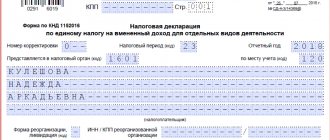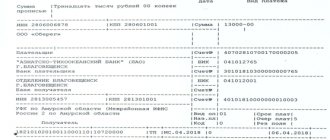Briefly about the invoice for payment
This document contains the payment details of the recipient, according to which the payer makes payment for the goods (work, services) listed in the invoice. The invoice for payment does not reflect any fact of economic life, therefore it is not included in the list of primary documents listed in Law No. 402-FZ “On Accounting”. There is also no single form of document approved by law.
The main purpose of the invoice is to notify the counterparty’s accounting department that it needs to transfer funds to the supplier in payment for the goods (work, services) indicated in the invoice. In addition, it serves as an offer when concluding a contract. The correctness of the invoice for payment is certified by the signature of the head of the organization and the accountant. Most often, a document is issued after a written agreement is concluded between organizations, but in some situations it is also issued as an independent document.
The specific validity period of the invoice for payment is not established by law. The payment term is not a mandatory detail, so it may not be indicated in payment documents.
When drawing up contracts (supply, contract, provision of services, etc.), the payment period is often tied to the time of receipt of the invoice. But this should not be done, since counterparties may delay the transfer of funds, citing the fact that the document was not received. It is better to count the period from the date of conclusion of the contract, shipment of inventory items, delivery of completed work according to the act, etc.
What does the bill look like?
An invoice for payment can hardly be considered in the general case a primary accounting document, since it does not formalize a business transaction (Clause 1, Article 9 of Federal Law No. 129-FZ “On Accounting”): the shipment of goods is issued with an invoice, the transfer of funds - payment order. The invoice performs auxiliary functions: the supplier informs the buyer of the amount to be paid and additionally reminds of the timing of its transfer.
There is no unified form for payment invoices; organizations resolve this issue independently. Traditional account details include:
- details of the supplier - the recipient of the payment, namely name, INN, KPP, bank details (it is assumed that it is on the basis of the invoice that the buyer will draw up a payment order in the form approved in Appendix 1 to the Regulations of the Central Bank of the Russian Federation dated No. 2-P “On non-cash payments in Russian Federation");
- buyer's details (usually only name);
- basis for payment (name, quantity of goods, details of the supply agreement);
- the amount to be paid (if a product is paid for, the sale of which is subject to VAT, the “input” tax is highlighted in the invoice);
- the deadline for paying the invoice (for example, “pay the invoice within 20 calendar days”);
- invoice expiration date (usually in prepaid invoices);
- date and account number (to identify the document);
- signature of an authorized person and seal of the supplier organization.
The legislation does not prohibit concluding transactions in conventional units (clause 2 of Article 317 of the Civil Code of the Russian Federation). This means that the invoice can also be drawn up in y. e. and contain an indication of the rate of conventional monetary units used by the parties (the official exchange rate on the date of payment or the rate fixed in the agreement).
For the purchasing organization, the invoice for payment usually performs a control function. For example , according to the internal document flow rules, a payment from a current account can only be made on the basis of an invoice from a supplier, endorsed by the financial manager. However, often the parties do without issuing invoices, because the amount of debt and payment terms are agreed upon in the contract. Most often, an invoice for payment is considered as a unilateral financial document, which in itself does not give rise to the rights and obligations of the parties.
Prepayment invoice as a contract
As a rule, in the supply agreement the parties stipulate the supplier’s obligation to issue an invoice for an advance payment or for payment for goods already shipped. Therefore, issuing an invoice is one of the actions of the supplier to fulfill its obligation under the contract.
However, there are situations when, due to the peculiarities of the organization of trade, issuing an invoice acts as an offer, and payment of the invoice is considered as acceptance of the offer (Resolutions of the FAS ZSO dated N F04-3677/2009(9195-A45-4), FAS UO dated N F09-8079/ 09-C3, FAS SZO from N A56-9218/2008, FAS PO from N A57-19204/05-15). So, according to paragraph 2 of Art. 437 of the Civil Code of the Russian Federation, an offer containing all the essential terms of the contract, from which the will of the person making the offer is discerned, to conclude an agreement on the conditions specified in the offer with anyone who responds, is recognized as an offer (public offer). In turn, the performance by the person who received the offer, within the period established for its acceptance, of actions to fulfill the terms of the contract specified in it (shipment of goods, provision of services, performance of work, payment of the appropriate amount, etc.) is generally considered acceptance .
Account elements
There is no specific form for drawing up an invoice, but there are mandatory components that must be contained in it.
- Requisites individual entrepreneur or LLC (both seller and buyer):
- name of the enterprise;
- legal form of organization;
- legal address of registration;
- Checkpoint (for legal entities only).
- Information about the bank servicing the transaction:
- name of the banking institution;
- his BIC;
- numbers of current and correspondent accounts.
- Payment codes:
- OKPO;
- OKONH.
- Account number and date of its registration (this information is for internal use of the company; numbering is continuous, starting from the beginning every year).
- VAT (or lack thereof). If VAT is present, its amount is indicated.
- Last name, initials, personal signature of the compiler.
Is an invoice required?
The legislation of the Russian Federation does not regulate the mandatory use of an invoice in business documentation; payment can be made simply on the terms of an agreement. However, the law calls the conclusion of an agreement an indispensable condition of any transaction. An invoice does not exist separately from the contract; it is a document accompanying the transaction. It represents, as it were, a preliminary agreement on payment according to the conditions established by the seller - the price that the buyer of the product or service must pay.
The invoice makes calculations much more certain, so entrepreneurs prefer to use it, even if this condition is not specified in the terms of the contract.
IMPORTANT! Since the requirement for an account is not legally required, it does not relate to accounting reporting documents, but is intended for internal use.
In what situations is an invoice issued?
Before the start of any cooperation, counterparties, as a rule, enter into agreements that stipulate payment terms, amounts and other terms of transactions. In addition, our legislation does not require transactions without contracts.
If the terms of the contract do not stipulate that the seller must issue an invoice for payment, there is no need to do this. In this case, the buyer must pay for the service or product only on the basis of an agreement.
This may be the case, for example, when paying for communication services: in contracts of this kind, the amount, as a rule, is not specified in advance. An invoice is issued when an organization carries out transactions subject to VAT, and in other cases established by law.
Such an invoice should be issued to the customer (or buyer):
- an organization exempt from VAT (Article 145 of the Tax Code of the Russian Federation);
- an organization that sells goods or services under an agency agreement on its own behalf, subject to the application of the general taxation system, clause 1 of Art. 169 Tax Code of the Russian Federation;
- an organization that has received an advance/partial payment towards the upcoming sale of goods from the customer (Article 168 of the Tax Code of the Russian Federation).
When is an account absolutely necessary?
The legislation specifies the moments when issuing an invoice is mandatory support for a transaction:
- if the text of the agreement did not specify the amount to be paid (for example, for communication services, etc.);
- for transactions involving the payment of VAT;
- if the selling organization is exempt from VAT;
- a selling company located on OSNO sells goods on its own behalf or provides services under agent agreements;
- if the customer made an advance payment to the seller company or transferred an advance payment for a product or service.
So, an invoice for payment is not a mandatory document , just like an accountable document. It cannot in any way influence the movement of financial funds, it can be suspended or not paid at any time - such phenomena occur quite often and do not have any legal consequences. However, this document is equally important for the parties to the transaction, as it allows them to enter into a kind of preliminary agreement on the transfer of funds.
Who issues invoices for payment?
An invoice for payment is always issued by an employee of the accounting department. After the form is completed, the document is handed over to the head of the organization, who certifies it with his signature. It is not necessary to put a stamp on the document, since individual entrepreneurs and legal entities (since 2021) have the right not to use the seal.
An invoice for payment is drawn up in two copies , one of which is sent to the service consumer or buyer, the second remains with the organization that issued it. You can fill out the invoice either on a regular A4 sheet or on the organization’s letterhead. The second option is more convenient, since you do not need to enter information about the company each time.
This document does not have a unified template, therefore organizations and individual entrepreneurs have the right to develop and use their own template or issue an invoice for payment in free form. As a rule, for long-established organizations and individual entrepreneurs the form of the form is standard; only the information about the invoice recipient, the name of the product or service, as well as the amount and date change. Sometimes organizations additionally indicate in the invoice the terms of delivery and payment (for example, percentage or prepayment amount), the validity period of the invoice and other information.
If any errors are made in the document during registration, it is better not to correct them, but to issue the invoice again.
It should be remembered that in some cases, when resolving disagreements between the parties in court, the invoice for payment is a document of legal force and can be presented in court.
Can I issue an invoice from an individual?
Since individuals who are not registered as individual entrepreneurs do not pay VAT, and an invoice can only be issued by an organization or individual entrepreneur with VAT, this function is not directly available to them .
Any serious company will not pay an invoice issued by an individual, exposing itself to taxes. Or you will have to register as an individual entrepreneur/closed joint stock company/LLC in order to be able to issue invoices, or draw up an agreement with an organization for the provision of a certain type of service, and it makes payment as an individual for the work performed. So, from a legal point of view, an individual and invoicing are incompatible concepts.
Invoice for payment from an individual entrepreneur or LLC
Today there is no form approving the type of account or suggesting its standard . It is not even considered an accounting document. An invoice is issued and issued for payment electronically or in paper form. Be sure to indicate the following:
- details of an individual entrepreneur or legal entity (identification code, name of the organization, its legal form and legal address);
- details of the servicing bank (name, address, current and correspondent accounts, BIC);
- codes (OKPO, OKONH).
After the individual entrepreneur has indicated his and the buyer’s details, the invoice number and the date of its formation are entered and the presence or absence of VAT is indicated. At the end of the individual entrepreneur’s document, you must indicate your last name, initials and sign. It is not necessary to put a stamp.
It’s even better to use a special program that generates invoices. In addition, it will automatically keep records of all completed transactions, significantly simplifying accounting reporting. It will also allow you to track the payment of bills, eliminating the occurrence of errors, for example, transferring money to another account.
What is the difference between invoices for payment from LLC and individual entrepreneur
The sample received from the “private owner” has one signature. The LLC will issue a paper containing two “autographs” - the chief accountant and the director. Besides:
- Individual entrepreneurs indicate only full name, companies - the name recorded in the charter;
- The individual entrepreneur form contains only the TIN, the organization - TIN and KPP.
Differences when issuing with VAT and without VAT
VAT payers show the tax amount separately.
If the supplier is exempt from the contribution due to the use of a special tax regime (simplified system, single tax, patent), then the VAT amount is not included when writing the document. However, the corresponding mark is still affixed. And the reason must be given. For example, under the simplified tax system it is written:
- for individual entrepreneurs - paragraph 2 of Article 346.11 of the Tax Code of Russia>;
- organizations - paragraph 3 of this regulatory act.
What conditions must be met?
Transfers through online services are becoming increasingly popular because they are convenient and functional. Today, anyone can download a payment application to their phone and send funds to their account with one click. From a security point of view, this is not entirely correct, but it is convenient.
Online banking allows you to pay bills at any time
In order to carry out a translation, it is necessary to follow a number of rules that will not only allow the procedure to be carried out accurately, but will also save translation time:
- To make a payment you need to log in to your personal account. All connections are made via a secure Internet connection and using the plastic owner’s personal mobile phone;
- Only the owner of the plastic card can use your personal account. For these purposes, you can contact the Sberbank office and order Maestro plastic, which is issued free of charge and issued instantly upon presentation of a passport;
- passwords, identifiers and security codes from the card cannot be transferred to third parties either in person or by telephone, even if the third party is a bank employee;
- In your personal account, you need to immediately set up security settings. So, when going online, the client sees all available accounts and funds. Also, if a fraudster comes into your account, it is very easy to transfer funds from personal deposits. Security settings allow you to hide the most important information;
- To make an online payment, you do not need to provide documents, and the procedure can be carried out either on a computer or on a personal phone if you have Internet access;
- It is better to transfer a large amount through a bank cash desk, since this method is the most reliable.
So the rules are quite simple. They allow you to save funds and prevent fraudsters from accessing them.
Instructions for preparing an invoice for payment
From an office management point of view, this document should not cause any particular difficulties in developing and filling out.
At the top of the document information about the recipient of the funds is indicated. Here you need to indicate
- full name of the company,
- his TIN,
- checkpoint,
- information about the bank servicing the account,
- account details.
Next, in the middle of the line, write the name of the document, its number according to internal document flow, as well as the date of creation.
Then the payer of the invoice (also the consignee) is indicated: here it is enough to indicate only the name of the company that received the goods or services.
The next part of the document concerns the services directly provided or goods sold, as well as their cost. This information can be presented either in a simple list or in the form of a table. The second option is preferable, as it avoids confusion and makes the score as clear as possible.
In the first column of the table of services provided or goods sold, you must enter the serial number of the product or service in this document. In the second column - the name of the service or product (without abbreviations, concisely and clearly). In the third and fourth columns, you must indicate the unit of measurement (pieces, kilograms, liters, etc.) and quantity. In the fifth column you need to put the price per unit of measurement, and in the last column - the total cost.
If the company operates under the VAT system, then this must be indicated and highlighted in the invoice. If there is no VAT, you can simply skip this line. Then, below the right, the full cost of all goods or services is indicated, and under the table this amount is written in words.
Finally, the document must be signed by the organization’s chief accountant and manager.
What date should I issue an invoice for payment?
If you issue invoices and statements for the same service to the same clients from month to month, you can create a new document by simply copying the previous one. It is also very convenient to issue acts for a group of accounts at once. To do this, in the document register, you simply check the boxes opposite those accounts for which you need to issue closing documents.
With one click on the “Create” button, acts or invoices will be generated. Any document created in the service can be downloaded in Excel or PDF format. But the second document, the invoice, is a confirmation of the completed transaction for tax accounting; it is issued only by the service provider or the seller only after he has completed the transaction, and includes not only the total price, but also separately indicated VAT.
An invoice has a standard form, is a document of strict reporting and is submitted to the tax office, whereas an invoice is not. Since the legislation does not establish a specific form of invoice for payment
, then such a document can be presented in paper or electronic form. An individual entrepreneur has the right to draw up an invoice using special software, which will automatically generate documentation after entering the necessary data. You can also prepare the document yourself.
In this case, the supply agreement will be considered concluded only after the goods are transferred to the consumer and the delivery note is signed. But even after paying for the goods, the buyer, having such an imperfect invoice, will not be able to present claims to the supplier based on the supply agreement. For example, the buyer will not be able to demand that the product be replaced or its quantity changed.
But he has the right to demand the return of the money paid for the goods, based on unjust enrichment. On our website you can find free invoices for 2021, compiled based on the requirements of the most common accounting programs.
- outgoing and incoming own number;
- name, contact details of the seller;
- information and contact details of the buyer or customer;
- discharge date;
- company and tax information;
- date of dispatch/delivery/purchase/services rendered;
- order number or other number by which the customer can track the progress of delivery;
- total amount;
- payment terms;
- and other information, for example, special conditions, information about taxes, penalties for late delivery, late payment or refunds in case of damage to the order.
Such an invoice may be issued by the seller (or performer) after the sale of goods or services. It is used to confirm payment of VAT and excise duty. In addition, it can inform about the country of origin of the goods and contains information about the customs declaration number (if the goods are imported).
It is issued in a strictly established form and is considered the basis for deducting VAT amounts from the buyer. Issued in two copies. Any serious company will not pay an invoice issued by an individual, exposing itself to taxes.
Or you will have to register as an individual entrepreneur/closed joint stock company/LLC in order to be able to issue invoices, or draw up an agreement with an organization for the provision of a certain type of service, and it makes payment as an individual for the work performed. So, from a legal point of view, an individual and invoicing are incompatible concepts. It indicates the seller or performer of a certain work (as a legal entity or individual entrepreneur), current account number and bank details, address, list of goods or services that are subject to payment.
Login to Sberbank online
Before carrying out the procedures, you need to visit your personal account. Login is made only with credentials. To open access you need to do the following:
- go to the website and in the upper right corner click on “login to Sat online”;
- go to the registration page and enter the card number and code from the picture on the screen;
- After this, the system will send an SMS code, which confirms access to your personal account. A login will appear in the registration form, which must be saved.
When you enter your account, a page with maps will open. The page provides complete information on plastic, including details.
How long is an invoice valid for payment according to law?
An invoice for payment can hardly be considered in the general case a primary accounting document, since it does not formalize a business transaction (Clause 1, Article 9 of the Federal Law of November 21, 1996 N 129-FZ “On Accounting”): the shipment of goods is issued with an invoice, transfer of funds - by payment order. The invoice performs auxiliary functions: the supplier informs the buyer of the amount to be paid and additionally reminds of the timing of its transfer.
To answer this question, it is necessary to establish whether the buyer (customer) had the opportunity to pay for goods (work, services) without receiving invoices from the supplier (contractor, performer). In other words, is the absence of an invoice after the parties have signed invoices for the transfer of goods, certificates of work performed, services rendered an obstacle to payment under the contract?
Replenishment for advertising agencies
It is more convenient and profitable for advertising agencies and anyone who has clients to replenish their balance through services such as Elama. With the help of an affiliate program you can get good rewards. You won’t be able to compensate from your own expenses; this scheme is only suitable for agencies.
The basic remuneration depends on your agency's turnover. It consists of the sum of expenses and transfers of all clients during the month. Calculated based on advertising accounts created in eLama. The basic remuneration is calculated as follows:
What happens if you don't pay your bill on time?
In the hustle and bustle of daily affairs, it is very important for an accountant or individual entrepreneur not to forget how many days an invoice is valid for payment, if it is defined. For late payment, you may have to pay a penalty, which is a way to ensure the obligations stipulated by the contract. The penalty is charged as a percentage for each day of delay in accordance with Art. 395 of the Civil Code of the Russian Federation.
From what day should the penalty begin to accrue? It all depends on the type of contract and the terms of payment in it. If the agreement clearly states the terms of payment, the penalty is calculated from the day following the last day of payment under the agreement.
If a clear date is not set, the calculation of the penalty is carried out as follows:
- under a supply agreement - after 3 working days from the date of transfer of the goods;
- under a work contract - after 7 days from the date of filing a claim with the debtor demanding payment.
Top up your balance with rewards
It is always nice to receive a reward, especially if you take into account VAT when paying for advertising in Yandex.Direct. Rewards can be received using services that are designed to work with Yandex.Direct. Let's tell you more about three of these services.
To open and view the service, click on the title with the link!
Click.ru
With its help, you can not only return part of the amount spent on advertising, but also get additional tools. They facilitate and help in setting up contextual advertising.
You can top up your balance through Click.ru. Then the commission will be 1-3% depending on the payment method. When using the service, you will get back up to 18% of your advertising costs.
The minimum top-up amount for Yandex.Direct is 1,200 rubles.
Through Click.ru you can receive a set of closing documents for accounting in a single window mode - for Google Ads, Yandex.Direct, myTarget and VK.
GetUniq
Another service for managing advertising campaigns from a single account.
The reward depends on your costs and advertising budget and other factors. But the higher the budget, the better the conditions.
Topping up your balance is also possible in various ways.
Elama
Here you can receive an agency fee of up to 10% of clients’ advertising turnover. The service also helps beginners and offers free advertising setup. Costs are only for advertising itself.
The invoice was not received on time: will there be a delay in payment?
—————————— Resolution of the Autonomous Region of the Moscow Region of September 10, 2014 N F05-8237/14 art. 190 Civil Code of the Russian Federation; Resolution 20 AAS dated 01.10.2012 N A62-2870/2012 clause 1 art. 486 Civil Code of the Russian Federation, clause 1, art. 711 Civil Code of the Russian Federation, clause 1, art. 779, paragraph 1, art. 781 of the Civil Code of the Russian Federation Resolution of the Federal Antimonopoly Service of the Russian Federation dated May 13, 2013 N F03-1578/2013 Resolution of the Federal Antimonopoly Service of the Moscow Region dated September 5, 2012 N A40-13105/12-137-119; FAS PO dated 04/22/2014 N A06-3458/2013; 13 AAS dated January 18, 2012 N A56-42250/2011; FAS North Caucasus Region dated 01.03.2013 N A53-22404/2012 clause 1 art. 486 Civil Code of the Russian Federation; clause 16 of the Resolution of the Plenum of the Supreme Arbitration Court of October 22, 1997 N 18; Part 5 Art. 5 of the Law of June 27, 2011 N 161-FZ, clause 2, art. 314 Civil Code of the Russian Federation; Resolution of the Federal Antimonopoly Service NWZ dated May 16, 2013 N A26-6244/2012; 13 AAS dated 08.11.2010 N A56-12577/2010
- under a supply (purchase and sale) agreement - after 3 working days (the period allotted to banks for transferring a non-cash payment) from the date of transfer of the goods. For example, if the goods were transferred on the 10th, then the last day of payment will be the 13th (provided that the days from the 11th to the 13th are working days), and the penalty will begin to accrue on the 14th;








